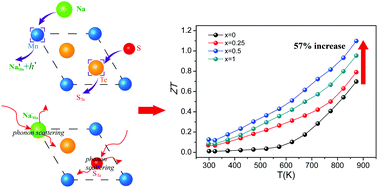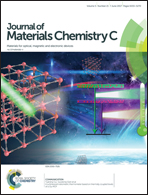Synergistic effect by Na doping and S substitution for high thermoelectric performance of p-type MnTe†
Abstract
Pristine MnTe is a p-type semiconductor with a relatively low hole concentration of 1018 cm−3, low electrical conductivity, and thus poor TE performance at room temperature owing to the broad direct band gap of 1.27 eV. In this study, Na2S was employed to be doped into the MnTe matrix to synergistically tune the electrical and thermal transport properties of the semiconductor via point defect engineering. On the one hand, Na substitution effectively improved the electrical transport properties by increasing the carrier concentration via the formation of acceptor-like defects, Na−Mn. On the other hand, thermal conductivities of the Na2S-doped samples were also sharply reduced via mass fluctuation and strain field fluctuation from the point defects introduced through Na doping and S substitution. Consequently, a maximum ZT of ∼1.09 was achieved for the 0.5 at% Na2S-doped sample at 873 K, which was the highest ZT value ever reported for p-type MnTe-based thermoelectric materials. Moreover, the high performance 0.5 at% Na2S-doped sample also exhibited good thermal stability and mechanical stability (Vickers microhardness) of ∼122 Hv, which was higher than those of other promising thermoelectric materials such as Bi2Te3, PbTe, PbSe, Cu2Se, and SnTe.



 Please wait while we load your content...
Please wait while we load your content...